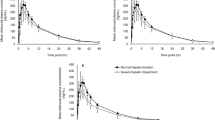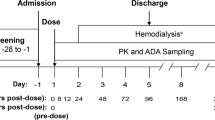Abstract
Background and Objective
Pradigastat, a diacylglycerol acyltransferase1 inhibitor, is being developed for the treatment of familial chylomicronemia syndrome. The primary objective of this clinical study was to evaluate the effect of renal impairment on the pharmacokinetics of pradigastat.
Methods
In an open-label, parallel-group study, the single-dose (40 mg) pharmacokinetics of pradigastat were evaluated in patients with mild (n = 9), moderate (n = 10) and severe renal impairment (n = 9) compared with matched healthy subjects (n = 28). The protein binding and urinary excretion of pradigastat were also assessed in this study.
Results
In patients with mild and moderate renal impairment the geometric means of the maximum plasma concentration (C max) and the area under the plasma concentration–time curve from time zero to infinity (AUCinf) of pradigastat were similar as compared with healthy subjects. In patients with severe renal impairment, the geometric means of the C max and AUCinf increased by 40 % [geometric mean ratio 1.41; 90 % confidence interval (CI) 0.92–2.14] and 18 % (geometric mean ratio 1.18; 90 % CI 0.68–2.05), respectively. There was no significant correlation between renal function (measured by creatinine clearance) and C max or AUCinf. Protein binding values were >99 % and the urinary excretion of pradigastat was minimal in all subjects. There were no severe adverse events in the study and mild transient diarrhoea was the most common adverse event. The safety profile was similar between patients with renal impairment and healthy subjects.
Conclusion
There was no change in the pharmacokinetics of pradigastat in patients with mild and moderate renal impairment. In patients with severe renal impairment, the mean exposure C max and AUCinf of pradigastat were increased by 40 and 18 %, respectively.



Similar content being viewed by others
References
Yen CL, Stone SJ, Koliwad S, et al. DGAT enzymes and triacylglycerol biosynthesis. J Lipid Res. 2008;49:2283–301.
Sugandhan S, Khandpur S, Sharma VK. Familial chylomicronemia syndrome. Pediatr Dermatol. 2007;24:323–5.
Meyers CD, Gaudet D, Tremblya K, et al. The DGAT1 inhibitor LCQ908 decreases triglyceride levels in patients with the familial chylomicronemia syndrome. J Clin Lipidol. 2012;6:266–7.
Meyers CD, Wu MS, Amer A, et al. The DGAT1 inhibitor pradigastat decreases chylomicron secretion and prevents postprandial triglyceride elevation in humans. J Clin Lipidol. 2013;7:285.
Yan JH, Meyers D, Lee Z, et al. Pharmacokinetic and pharmacodynamic drug-drug interaction assessment between pradigastat and digoxin or warfarin. J Clin Pharmacol. 2014;54:800–8.
Upthagrove A, Einolf H, Hanna I, et al. Disposition of pradigastat (LCQ908) in humans: in vivo and in vitro investigations. Drug Metab Rev. 2013;45:33–269.
Nolin TD, Naud J, Leblond FA, et al. Emerging evidence of the impact of kidney disease on drug metabolism and transport. Clin Pharmacol Ther. 2008;83:898–903.
Sun H, Frassetto L, Benet LZ. Effects of renal failure on drug transport and metabolism. Pharmacol Ther. 2006;109:1–11.
Touchette MA, Slaughter RL. The effect of renal failure on hepatic drug clearance. DICP. 1991;25:1214–24.
Pichette V, Leblond FA. Drug metabolism in chronic renal failure. Curr Drug Metab. 2003;4:91–103.
Guidance for industry: pharmacokinetics in patients with impaired renal function—study design, data analysis, and impact on dosing and labeling. US Food and Drug Administration 2010. http://www.fda.gov/downloads/Drugs/Guidances/UCM204959.pdf. Accessed 18 Feb 2014.
Guidance for industry: pharmacokinetics in patients with impaired renal function—study design, data analysis, and impact on dosing and labeling.US Food and Drug Administration. 1998. http://www.fda.gov/downloads/Drugs/GuidanceComplianceRegulatoryInformation/Guidances/ucm072127.pdf. Accessed 27 April 2014.
Committee for Medicinal Products for Human Use. Note for guidance on the evaluation of the pharmacokinetics of medicinal products in patients with impaired renal function. 2004. http://www.ema.europa.eu/docs/en_GB/document_library/Scientific_guideline/2009/09/WC500003123.pdf. Accessed 18 Mar 2014.
Kulmatycki K, Meyers CD, Crissey A, et al. Pharmacokinetic evaluation of escalating single intravenous and multiple oral doses of pradigastat and its absolute bioavailabilty in healthy subjects. Presented at http://abstracts.aaps.org/Verify/aaps2013/postersubmissions/R6322.pdf. Accessed 23 June 2014.
Acknowledgments
We thank all the clinical investigators and study coordinators at the participating centres, and all the study participants. We would like to thank Andrew Joyson who is an ex-employee of Novartis. Andrew was the clinical trial lead for this study and was responsible for conducting the operational and reporting activities as the study lead. Andrew also contributed in the development and review of the manuscript. We also thank Mayurika Dutta, Novartis Healthcare Pvt. Ltd., India, for medical writing and editorial support.
Conflict of interest/disclosure
SM, DM, PP, TL, SR, GS and JC are full-time employee of Novartis. TM was a full-time employee of Novartis during the study conduct and manuscript development. Currently, TM is a full-time employee of Alcon Laboratories, Inc.
Author information
Authors and Affiliations
Corresponding author
Additional information
Registered at ClinicalTrials.gov as NCT01558323.
Rights and permissions
About this article
Cite this article
Mita, S., Meyers, D., Pal, P. et al. Effect of Renal Impairment on the Pharmacokinetics of Pradigastat, a Novel Diacylglycerol Acyltransferase1 (DGAT1) Inhibitor. Clin Pharmacokinet 54, 751–760 (2015). https://doi.org/10.1007/s40262-015-0234-x
Published:
Issue Date:
DOI: https://doi.org/10.1007/s40262-015-0234-x




